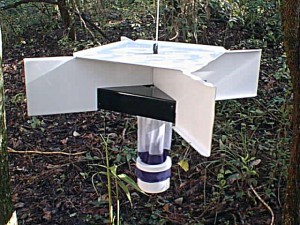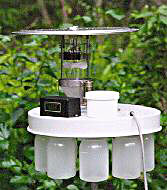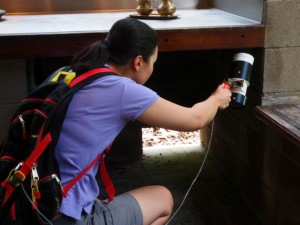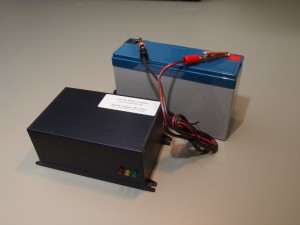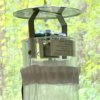 The UVA-LED Light Trap (Model 1612) is based on two years of research into the use of near ultra-violet radiation (UVA, peak wavelength of ca. 361 nm) for the attraction of hematophagous insects using light emitting diodes (LEDs). This research led to the development of the Stealth Trap (Model 2014) for our US Department of Defense and now to a civilian version, the model 1612. The 1612 uses 6.3 VDC and consumes only 300 mAmps. The trap has a almost twice the runtime of the Miniature Incandescent Light Trap Model 1012 and three times the runtime of the Blacklight (UV) Model 1212.
The UVA-LED Light Trap (Model 1612) is based on two years of research into the use of near ultra-violet radiation (UVA, peak wavelength of ca. 361 nm) for the attraction of hematophagous insects using light emitting diodes (LEDs). This research led to the development of the Stealth Trap (Model 2014) for our US Department of Defense and now to a civilian version, the model 1612. The 1612 uses 6.3 VDC and consumes only 300 mAmps. The trap has a almost twice the runtime of the Miniature Incandescent Light Trap Model 1012 and three times the runtime of the Blacklight (UV) Model 1212.
Welcome
The John W. Hock Company specializes in tools for collecting mosquitoes and other insects. Our tools are used for scientific research, risk assessment, and vector-borne disease control programs.
Latest News
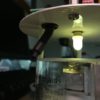 The white LED lamp with miniature bayonet base uses 6.3 VDC and only draws 20 mAmps. This is in marked contrast to the 150 and 250 mAmps for the CM-47 and CM-44, respectively. Extremely long life and cool operating temperature. Can be used in the following trap models: 512, 512.MIL, 1012, 1012.GATE, 1012.co2, and 1012.MIL. If used in a CDC light trap, PN: 512 running on a 6-volt 12 amp-hr battery, run time would be increased from 27 to 45 hours. If used in the New Standard Miniature Light Trap, PN: 1012, run time would be increased from 22 hours (CM-44) to 53 hours (PN 3.20). Other colors available are Green: 525 nm (nano-meters), Blue: 473 nm, Yellow: 592 nm, and Red: 626 nm.
The white LED lamp with miniature bayonet base uses 6.3 VDC and only draws 20 mAmps. This is in marked contrast to the 150 and 250 mAmps for the CM-47 and CM-44, respectively. Extremely long life and cool operating temperature. Can be used in the following trap models: 512, 512.MIL, 1012, 1012.GATE, 1012.co2, and 1012.MIL. If used in a CDC light trap, PN: 512 running on a 6-volt 12 amp-hr battery, run time would be increased from 27 to 45 hours. If used in the New Standard Miniature Light Trap, PN: 1012, run time would be increased from 22 hours (CM-44) to 53 hours (PN 3.20). Other colors available are Green: 525 nm (nano-meters), Blue: 473 nm, Yellow: 592 nm, and Red: 626 nm.
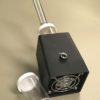 The design and testing of our new Battery-Powered Mosquito and San Fly Aspirator Model 419 was completed in April of 2018. This aspirator can be used to move mosquitoes and sand flies between cages in the laboratory; it can be used in field collections and to conduct human landing rate counts in the field. Suction is provided by a cooling fan which operates at 5-6 VDC. Three 7-dram vials fitted with fine mesh stainless steel cloth for air flow and snap-on lids are included with the aspirator. The polycarbonate intake tube is 4 inches long with an ID of 0.375 inches. The aspirator comes with a waterproof battery case and is supplied with four alkaline AA batteries. The aspirator also includes a set of alligator leads so the unit can be powered using any size or type of 6-volt battery, e.g., our 6 VDC 12 Amp Hr gel cell (PN: 2.30) or our waterproof Pelican 4 D-Cell Battery Holder (PN: 1.50). Also included is an extension cord and a universal power supply (wall adaptor) that can operate on 100-240 VAC and 50/60 Hz mains. All connectors are either male or female 5.5/2.1 mm barrel connectors.
The design and testing of our new Battery-Powered Mosquito and San Fly Aspirator Model 419 was completed in April of 2018. This aspirator can be used to move mosquitoes and sand flies between cages in the laboratory; it can be used in field collections and to conduct human landing rate counts in the field. Suction is provided by a cooling fan which operates at 5-6 VDC. Three 7-dram vials fitted with fine mesh stainless steel cloth for air flow and snap-on lids are included with the aspirator. The polycarbonate intake tube is 4 inches long with an ID of 0.375 inches. The aspirator comes with a waterproof battery case and is supplied with four alkaline AA batteries. The aspirator also includes a set of alligator leads so the unit can be powered using any size or type of 6-volt battery, e.g., our 6 VDC 12 Amp Hr gel cell (PN: 2.30) or our waterproof Pelican 4 D-Cell Battery Holder (PN: 1.50). Also included is an extension cord and a universal power supply (wall adaptor) that can operate on 100-240 VAC and 50/60 Hz mains. All connectors are either male or female 5.5/2.1 mm barrel connectors.
Prior to 2015, Zika virus (ZIKV) outbreaks were confined to Africa, Southeast Asia, and the Pacific Islands. In May of 2015 the Pan American Health Organization (PAHO) issued an alert regarding the first confirmed ZIKV infections in Brazil. Currently, outbreaks are occurring in many countries in the Americas. As of 30 January 2016, ZIKV has been reported from Barbados, Bolivia, Brazil, Colombia, Dominican Republic, Ecuador, El Salvador, French Guiana, Guadeloupe, Guatemala, Guyana, Haiti, Honduras, Jamaica, Martinique, Mexico, Panama, Paraguay, Puerto Rico, Saint Martin, Suriname, U.S. Virgin Islands, and Venezuela. CDC and PAHO/WHO are forecasting that ZIKA will continue to spread in the Americas. The John W. Hock Company makes many traps that are useful and specific for the vectors of ZIKA. Click here for more information on Zika virus and recommendations for traps and aspirators.
